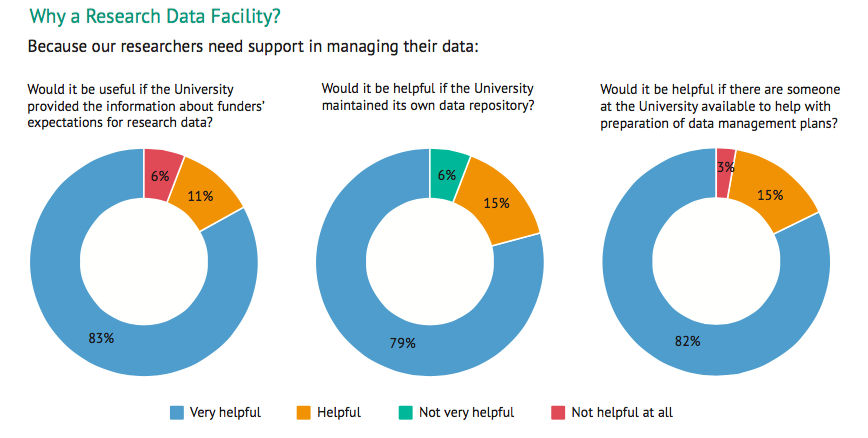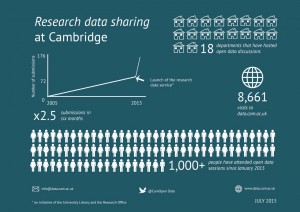The Repository Fringe was held in Edinburgh on 3-4 August. With the theme of “Integrating repositories in the wider context of university, funder and external services”, the event brought together repository managers across the UK to discuss practice and policy. Dr Arthur Smith, Open Access Research Advisor at the University of Cambridge, attended the event and came away with the impression that more needs to be done to embed open access in scholarly processes.
In his keynote speech to Repository Fringe 2015, titled ‘Fulfilling their potential: is it time for institutional repositories to take centre stage?’ David Prosser, Executive Director of Research Libraries UK (RLUK) gave a concise overview of the history surrounding open access and the situation we currently find ourselves in, especially in the UK.
What’s become clear is that ‘we’ is a problematic term for the scholarly communications community. A lack of cohesion and vision between librarians, repository managers and administrators means ‘we’ have failed to engage with researchers to make the case for open access.
I feel this is due to, in part, the fragmented nature of repositories stemming from an institutional need for control. If national (and international) open access subject repositories had been created and exploited perhaps researcher uptake of open access in the UK and around the world would have been faster. For example, arXiv continues to be the one stop shop for physicists to publish their manuscripts precisely because it’s the repository for the entire physics community. That’s where you go if you’ve got a physics paper. To be fair, physics had a culture of sharing research papers that predates the internet.
Repositories are only as good as the content they hold, and without support from the academic community to fill repositories with content, there is a risk of side-lining green open access*. This will in turn increase the pressure to justify the cost of ineffective institutional repositories.
As David correctly identified, scholars will happily take the time to do things they feel are important. But for many researchers open access remains a low priority and something not worth investing their time in. Repositories are only capturing a fraction of their institution’s total publication output. At Cambridge we estimate that only 25-30% of articles are regularly deposited.
Providing value
The value of open access, whether it’s green or gold**, isn’t obvious to the authors producing the content. Yet juxtaposed with this is a report prepared by Nature Publishing Group on 13 August: Perceptions of open access publishing are changing for the better. This examined the changing perceptions of researchers to open access. While many researchers are still unaware of their funders’ open access requirements, the general perception of open access journals in the sciences has changed significantly, from 40% who were concerned about the quality of OA publication in 2014, to just 27% in 2015.
Clearly the trend is towards greater acceptance of open access within the academic community, but actual engagement remains low. If we don’t want to end up in a world of expensive gold open access journals, green repositories must be competitive with slick journal websites. Appearances matter. We need to attract the attention of the academics so that open access repositories are seen as viable places for disseminating research.
The scholarly communications community must find new ways of making open access (particularly green open access) appealing to researchers. One way forward is to augment the reward structure in academic publishing. Until open access is adopted more widely, academics should be rewarded for the effort involved in making their work openly available.
In the UK, failure to comply with the Higher Education Funding Council for England (HEFCE) and other funders’ policies could seriously affect future funding outcomes. It is the ever-present threat of funding cuts which drives authors to choose open access options, but this has changed open access into a policy compliance debacle.
Open access as a side effect of policy compliance is not enough; we need real support from academics to propel open access forward.
Measuring openness
As a researcher, the main things I look for when assessing other researchers and their publications are h-index, total and article level citations, and journal prestige (impact factor). I am not aware of any other methods which so simply define an author’s research.
While these types of metrics have their problems, they are nonetheless widely used within the academic community. An annual openness index, which is simply the ratio of open access articles to the total number of publications, would quickly reveal how open an academic’s research publications are. This index could be applied equally to established professors and early career researchers, as unlike the h-index, there is no historical weighting. It only depends on how you’re publishing now.
Developing such a metric would spur on open access from within academic circles by making open access publishing a competition between researchers. Perhaps the openness index could also be linked to university progression and grant reward processes. The more open access your work is, the better it is for you, and as a consequence, the community.
Open access needs to stop being a ‘fringe’ activity and become part of the mainstream. It shouldn’t be an afterthought to the publication process. Whether the solution to academic inaction is better systems or, as I believe, greater engagement and reward, I feel that the scholarly communications and repository community can look forward to many interesting developments over the coming months and years.
However, we must not be distracted from our main goal of engaging with researchers and academics to gather content for the open access repositories we have so lovingly built.
Glossary
*Green open access refers to making a copy of a published work available by placing it in a repository. This can be thought of as ‘secondary’ open access.
**Gold open access is where the research is published either in a fully open access journal – which sometimes incurs an article processing charge, or in a hybrid journal – which imposes an article processing charge to make that particular article available and also charges a subscription for the remainder of the articles in the journal. This can be thought of as ‘born’ open access.


 This infographic demonstrates how successful the Research Data Facility has been. Prepared by Laura Waldoch from the University Library, it is
This infographic demonstrates how successful the Research Data Facility has been. Prepared by Laura Waldoch from the University Library, it is